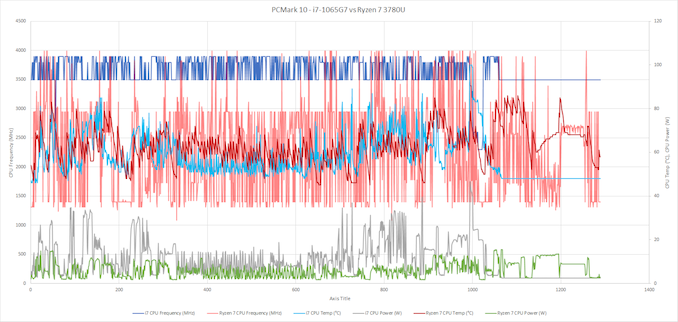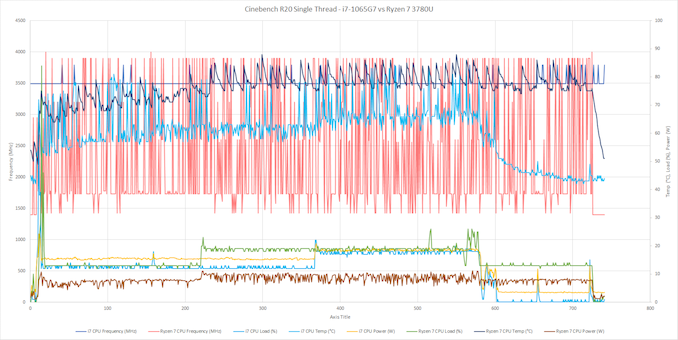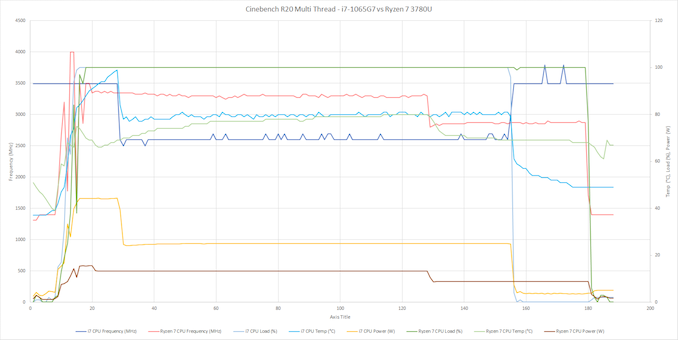The Microsoft Surface Laptop 3 Showdown: AMD's Ryzen Picasso vs. Intel's Ice Lake
by Brett Howse & Andrei Frumusanu on December 13, 2019 8:30 AM ESTBenchmark Analysis: Boost Behavior
Let’s dig into some of the testing to see how the systems responded during the benchmarks. We re-ran several of the tests while simultaneously monitoring the processor frequency, temperature, and power. Unfortunately for our comparison, the power polling results provided by our monitoring tools don’t seem to monitor the same power draw. The Intel power numbers are for the SoC package, but the AMD power numbers appear to be just the CPU cores, which is an unfortunate byproduct of testing two different platforms.
PCMark 10
PCMark 10 is a benchmark platform that attempts to simulate real-world tasks by running a variety of workflow, and the results were perhaps the most interesting of any of the benchmarks. There is a major discrepancy in how the AMD CPU behaved compared to the Intel. The Ice Lake platform kept the CPU frequency at a minimum of 3.5 GHz, with bursts to 3.9 GHz when under load. The Picasso processor was very aggressively switching from low frequency to high frequency, and was rarely indicating that it was over 3.0 GHz, but clearly demonstrating its higher peak frequency of 4.0 GHz in several locations. Both systems were fairly even in terms of CPU temperature, and Intel’s aggressive turbo levels were evident with peak power levels of 40 Watts for brief moments. The Ice Lake platform finished the benchmark about 200 seconds quicker than the Picasso system.
Cinebench R20 Single-Thread
We see somewhat similar results when only a single CPU core is loaded with the Picasso CPU frequency varying quite a bit. There’s also an average higher temperature on the AMD platform during this workload, and once again Ice Lake finishes the rendering quite a bit sooner thanks to its stronger CPU cores.
Cinebench R20 Multi-Thread
With all cores loaded the graph is considerably altered. Here the AMD processor is able to maintain a much higher frequency across its cores for much longer, while Intel's chip is only able to maintain 3.5 GHz for about 30 seconds before it runs out of headroom, dropping the cores down to around 2.6 GHz. But despite the lower frequency, the much higher IPC on Sunny Cove allows the Ice Lake platform to finish quite a bit sooner.













174 Comments
View All Comments
MBarton - Monday, December 30, 2019 - link
There's a lot more money in server and retail desktop CPU's than there are in sub-$1000 mobile parts. Why would AMD send perfect good Zen 2 cores to the mobile market if they can sell them as something with better margins?Teckk - Friday, December 13, 2019 - link
There's no way to recommend an AMD laptop yet. Intel has all the numbers both in terms of performance and in terms of the various models by different OEMs. Lot to catch up for AMD. This market is Intel's to lose and by the looks of the integrated graphics in this, seems to be a tough task for AMD.5080 - Friday, December 13, 2019 - link
Zen 2 based APU's (Renoir) will easily catch up to Intel's mobile CPU lineup. We can assume that graphics and storage performance will be much better since NVMe can use the PCIe 4.0 bus and AMD's iGPU was always ahead of Intel. We will know soon since AMD is scheduled to release Renoir on CES in January. Microsoft should have waited for Renoir before putting it into its Surface.smilingcrow - Friday, December 13, 2019 - link
Looking at the current high power draw of PCIe 4.0 I can't see it being attractive for mobile just yet, especially as battery life is generally more important than 5GB/s storage speeds in laptops.GreenReaper - Friday, December 13, 2019 - link
If you can use half the lanes I can totally see it being attractive - just as a quad-core may use less power than an octa-core. The main issue on the desktop is wanting the same number of faster lanes.MBarton - Monday, December 30, 2019 - link
Exactly. AMD showing up with Zen 2 and x570's PCIe 4.0 wouldn't have carried much weight if they sacrificed lane count in the process.RSAUser - Friday, December 13, 2019 - link
It doesn't pull the full required power at all times, it's fine for burst.Still think it doesn't really make sense though as you don't need the speed in any laptops right now as no drive can properly max it.
RSAUser - Friday, December 13, 2019 - link
Storage speed is relative, most would not notice the speedup.MASSAMKULABOX - Sunday, December 15, 2019 - link
Anybody care to mak any predictions on how much better the rRenoir Igpu will be compared to the 2400/3400g .. I'm thinking maybe a 25% uplift but maybe more it its NAVI. However everyone seems to be foregtting they have done most of the work , in getting out the Head Canyon NUC for Intel. they can announce in Jan with general avail in 2,3,6 months ??scineram - Monday, December 16, 2019 - link
No.